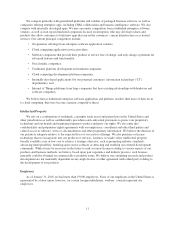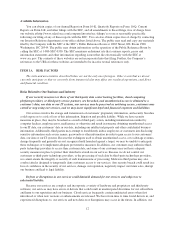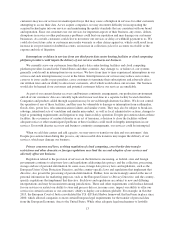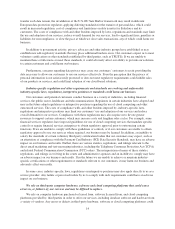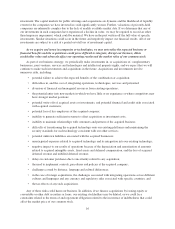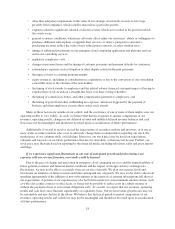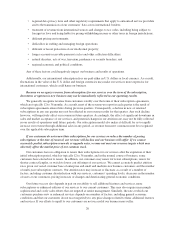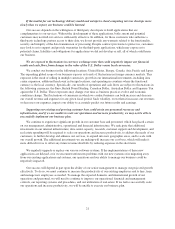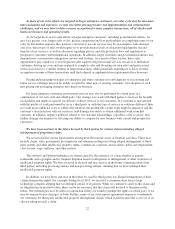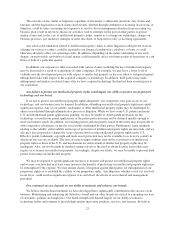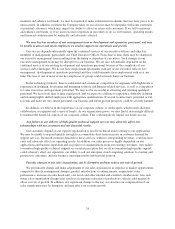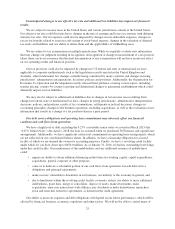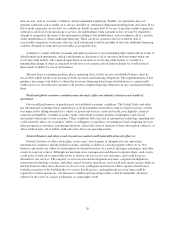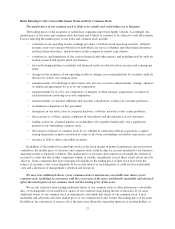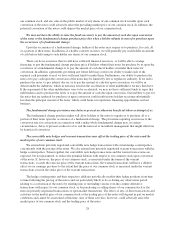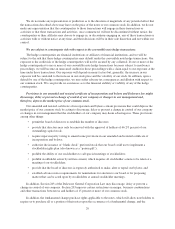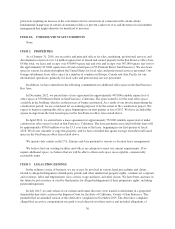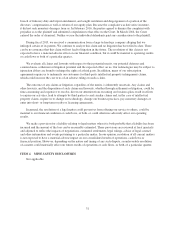Salesforce.com 2016 Annual Report Download - page 28
Download and view the complete annual report
Please find page 28 of the 2016 Salesforce.com annual report below. You can navigate through the pages in the report by either clicking on the pages listed below, or by using the keyword search tool below to find specific information within the annual report.If the market for our technology delivery model and enterprise cloud computing services develops more
slowly than we expect, our business could be harmed.
Our success depends on the willingness of third-party developers to build applications that are
complementary to our services. Without the development of these applications, both current and potential
customers may not find our services sufficiently attractive. In addition, for those customers who authorize a
third-party technology partner access to their data, we do not provide any warranty related to the functionality,
security and integrity of the data transmission or processing. Despite contract provisions to protect us, customers
may look to us to support and provide warranties for the third-party applications, which may expose us to
potential claims, liabilities and obligations for applications we did not develop or sell, all of which could harm
our business.
We are exposed to fluctuations in currency exchange rates that could negatively impact our financial
results and cash flows from changes in the value of the U.S. Dollar versus local currencies.
We conduct our business in the following locations: United States, Europe, Canada, Asia Pacific and Japan.
The expanding global scope of our business exposes us to risk of fluctuations in foreign currency markets. This
exposure is the result of selling in multiple currencies, growth in our international investments, including data
center expansion, additional headcount in foreign locations, and operating in countries where the functional
currency is the local currency. Specifically, our results of operations and cash flows are subject to fluctuations in
the following currencies: the Euro, British Pound Sterling, Canadian Dollar, Australian Dollar and Japanese Yen
against the U.S. Dollar. These exposures may change over time as business practices evolve and economic
conditions change. The fluctuations of currencies in which we conduct business can both increase and decrease
our overall revenue and expenses for any given fiscal period. Such volatility, even when it increases our revenues
or decreases our expenses, impacts our ability to accurately predict our future results and earnings.
Supporting our existing and growing customer base could strain our personnel resources and
infrastructure, and if we are unable to scale our operations and increase productivity, we may not be able to
successfully implement our business plan.
We continue to experience significant growth in our customer base and personnel, which has placed a strain
on our management, administrative, operational and financial infrastructure. We anticipate that additional
investments in our internal infrastructure, data center capacity, research, customer support and development, and
real estate spending will be required to scale our operations and increase productivity, to address the needs of our
customers, to further develop and enhance our services, to expand into new geographic areas, and to scale with
our overall growth. The additional investments we are making will increase our cost base, which will make it
more difficult for us to offset any future revenue shortfalls by reducing expenses in the short term.
We regularly upgrade or replace our various software systems. If the implementations of these new
applications are delayed, or if we encounter unforeseen problems with our new systems or in migrating away
from our existing applications and systems, our operations and our ability to manage our business could be
negatively impacted.
Our success will depend in part upon the ability of our senior management to manage our projected growth
effectively. To do so, we must continue to increase the productivity of our existing employees and to hire, train
and manage new employees as needed. To manage the expected domestic and international growth of our
operations and personnel, we will need to continue to improve our operational, financial and management
controls, our reporting systems and procedures, and our utilization of real estate. If we fail to successfully scale
our operations and increase productivity, we will be unable to execute our business plan.
21


